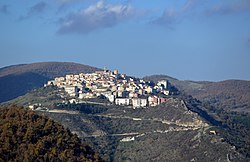Albano di Lucania
| Albano di Lucania | |
|---|---|
| Comune | |
| Comune di Albano di Lucania | |
 |
|
| Location of Albano di Lucania in Italy | |
| Coordinates: 40°35′N 16°2′E / 40.583°N 16.033°ECoordinates: 40°35′N 16°2′E / 40.583°N 16.033°E | |
| Country | Italy |
| Region | Basilicata |
| Province / Metropolitan city | Potenza (PZ) |
| Area | |
| • Total | 55 km2 (21 sq mi) |
| Elevation | 899 m (2,949 ft) |
| Population | |
| • Total | 1,602 |
| • Density | 29/km2 (75/sq mi) |
| Demonym(s) | albanesi |
| Time zone | CET (UTC+1) |
| • Summer (DST) | CEST (UTC+2) |
| Postal code | 85010 |
| Dialing code | 0971 |
| Patron saint | San Vito di Lucania |
| Saint day | 15 June |
| Website | Official website |
Albano di Lucania is a town and comune in the province of Potenza, in the Southern Italian region of Basilicata.
The origins of the town are uncertain, due to the limited written documentation. Over the centuries it was ruled by several noble families. Until 1301 it was ruled by the family of the Countess Filippa D'Alba. From 1301 onwards Albano was ruled by Pipino. In the fifteenth and sixteenth centuries Albano was part of the feud of Sanseverino. Until 1800 Albano was ruled by dukes Ruggiero.
There are several hypotheses about the origin of the name of the town. Some these indicate the name deriving from a leader of Albanian origin, the other from the historic Countess Filippa D'Alba. The accepted theory is that the name derives from the noble Roman family of Albius.
The coat of arms of Albano is a stylized tree, most likely an oak. The oak tree is meant to represent the great forest that stretched around Albano in the past and there are still stretches, though thinned by the various fields used for an agricultural purpose. The use of this emblem can be traced back to the end of the sixteenth century, as evidenced by a coat of arms located in the country side in 1581.
Like many other places of worship of Basilicata the present church seems to have been located on a previous place of worship, almost certainly an early Christian church. Subsequently, between 1200 and 1300, the present church was built in Romanesque style. Initially he was dedicated to Our Lady of the Snows(Madonna della neve) and from 1924 onwards it was dedicated to Our Lady of the Assumption(Santa Maria Maggiore). The main facade of the church has been closed since 1924, built in neoclassical style and in sharp contrast with the predominant Romanesque style, with a stone facade with some sagging. On the main facade there is a portal with a pointed arch, surmounted by a central rose window and two smaller side, that illuminate the interior of the church. On the right side wall is located on the lower portal, which also serves as the main entrance to the church since the main portal was closed in 1924. The church also has a large bell tower of stone eighteenth century with a cusp in 1967, that replaced and older spire struck by a lightning bolt in 1963. The bell tower has six bells. Inside, the building consists of three naves with twelve altars and one large altar in marble. A statue of the Madonna delle Grazie, attributed to Giacomo Colombo sec. XVII discovered by the scholar Michele Piccini.
...
Wikipedia

